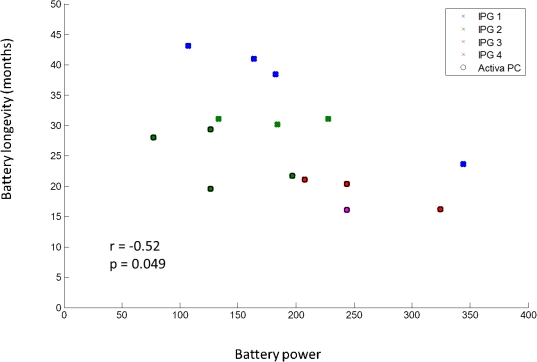Session Information
Date: Monday, June 20, 2016
Session Title: Surgical therapy: Parkinson's disease
Session Time: 12:30pm-2:00pm
Location: Exhibit Hall located in Hall B, Level 2
Objective: To determine whether the decrease in longevity following IPG replacement is due to programming changes and whether there is an effect of IPG model.
Background: Although rechargeable batteries in deep brain stimulation are becoming more popular this is not always an option for all patients. We have shown that the rate of battery depletion increases with each successive IPG replacement which may be due to a combination of both harware and programme-related issues.
Methods: Seven patients with PD treated with bilateral STN-DBS with at least one Kinetra followed by an Activa PC were identified retrospectively. Their medical records were carefully reviewed and a measure of battery drain or treatment power was derived from their stimulation parameters after each visit according to the following equation: [Voltage] ^2⁄Impedance×pusle width×frequency. Impedance was estimated as 1000 Ω.
Results: As expected there was a negative correlation between predicted battery energy expenditure according to the equation above, r = -0.52, p<0.05, and battery life dropped with time in all cases but one. 
| Longevity (months) – Power | |||||
| Patient | IPG 1 | IPG 2 | IPG3 | IPG4 | |
| P1 | 23.6 – 344 | 19.5 – 126 | |||
| P2 | 28.8 — | 31.1 – 133 | 21.1 – 207 | ||
| P3 | 38.4 – 182 | 21.7 – 197 | |||
| P4 | 40.0 — | 31.1 – 228 | 16.2 – 324 | ||
| P5 | 40.7 — | 30.2 – 184 | 20.4 – 244 | 16.1 – 244 | |
| P6 | 41.0 – 163 | 29.3 – 126 | |||
| P7 | 43.1 – 107 | 28.0 – 77 | |||
Conclusions: From this in-depth case series it appears that stimulation parameters often increase over time thus increasing battery drain and decreasing longevity with each replacement. This may be due to changes in the electrode-brain interface over time, brain plasticity causing habituation or attempts to treat to worsening symptom due to disease progression. The effect of IPG model beyond the use of higher stimulation parameters can best be attributed to the increased programming options such as the use of interleaving programs or repeated group changes which have a detrimental effect on battery life.
To cite this abstract in AMA style:
S.D. Israeli-Korn, S. Tessler, G. Yahalom, S. Benizri, O.S. Cohen, C. Shabat, H. Strauss, N. Warmann-Alaluf, E. Stein, Z. Zibly, R. Spiegelman, S. Hassin, S. Hassin. Reduction in battery longevity for each subsequent implantable pulse generator (IPG) in patients with Parkinson’s disease (PD) treated with bilateral subthalamic nucleus deep brain stimulation (STN-DBS) may be due to both programming changes and IPG model – a case series [abstract]. Mov Disord. 2016; 31 (suppl 2). https://www.mdsabstracts.org/abstract/reduction-in-battery-longevity-for-each-subsequent-implantable-pulse-generator-ipg-in-patients-with-parkinsons-disease-pd-treated-with-bilateral-subthalamic-nucleus-deep-brain-stimulation-stn-db/. Accessed October 23, 2025.« Back to 2016 International Congress
MDS Abstracts - https://www.mdsabstracts.org/abstract/reduction-in-battery-longevity-for-each-subsequent-implantable-pulse-generator-ipg-in-patients-with-parkinsons-disease-pd-treated-with-bilateral-subthalamic-nucleus-deep-brain-stimulation-stn-db/
